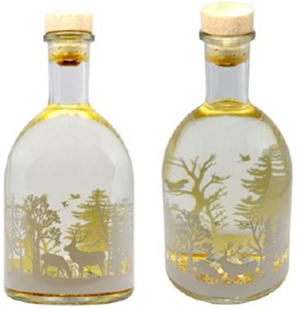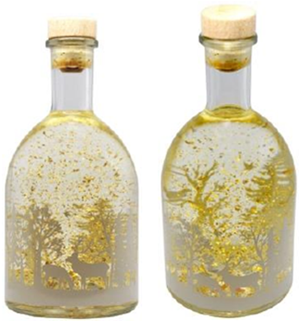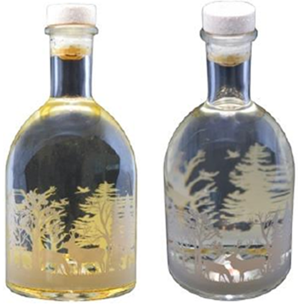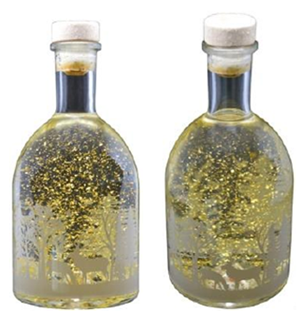UK Registered Design Infringement: The Battle Against Look-a-Likes
British retailer Marks and Spencer (M&S) recently succeeded in proceedings brought against budget supermarket chain, Aldi, for infringement of its UK registered design rights.
The case was heard by His Honour Judge Hacon (Hacon J) sitting in the Intellectual Property Enterprise Court (a specialist division of the High Court). Specifically, the case concerned Aldi’s sale of flavoured gin liqueurs, all of which were offered in light-up bottles containing gold flakes and which, when shaken, created an effect reminiscent of a snow globe (‘the Aldi Products’).
Images of the Aldi Products are shown below.
The Aldi Products

In M&S’ view, the Aldi Products were strikingly similar to its own gin liqueurs, all of which also contain gold flakes and are sold in bottles featuring an illuminated base. M&S has sold gin liqueur products in the UK to this design since the Autumn of 2020.
In bringing proceedings against Aldi, M&S alleged that the Aldi Products infringed several of its UK registered design rights, namely, UK design registration nos. 6134278, 6134280, 6134282 and 6134284, all of which relate to various bottle designs (‘the M&S Registrations’). Each of the M&S Registrations claimed an (unchallenged) priority date of 15 December 2020, pre-dating the sale of the Aldi Products by 11 months (the Aldi Products having first being marketed and sold in the UK in November 2021).
Images of the designs covered by the M&S Registrations are shown below.
The M&S Registrations
UK Design Registration No. 6134278 (‘Registration 1’)

UK Design Registration No. 6134280 (‘Registration 2’):

UK Design Registration No. 6134282 (‘Registration 3’):

UK Design Registration No. 6134284 (‘Registration 4’):

To establish infringement of its design registrations, M&S was required to prove that the Aldi Products did not produce on the informed user a different overall impression to that created by M&S’ own earlier designs. Accordingly, and in order to determine whether the Aldi Products did in fact infringe M&S’ rights, the Court had regard to the following:
- the interpretation of the design(s) claimed;
- the relevant sector;
- the informed user of the design, their awareness of prior art and level of attention paid;
- the degree of ‘design freedom’ and the extent to which the design(s) consist(s) of features solely dictated by technical function; and
- the design corpus
The Court also considered the extent to which the inclusion of ‘brand’ elements might affect the overall impression created by the later design on the informed user where the Aldi Products were sold under the name, ‘The Infusionist’, as represented on the front of the bottles.
Having considered the parties submissions and evidence on each of the above points, the Court determined that the features that the informed user would note as being in common between the M&S Registrations and the Aldi Products were as follows:
- The apparent identical bottle shapes
- The identical shapes of the bottle stoppers
- A winter scene over the entirety of the straight portion of the side, consisting in one case entirely, and in the other case mostly, of tree silhouettes.
- In the case of Registrations 2 and 4, a snow effect
- In the case of Registrations 3 and 4, an integrated light
On this basis, it was held that, with the design corpus in mind, each of these similarities “would appear significant to the informed user and cumulatively they would be striking”. Accordingly, the Court held that the Aldi Products bottles did infringe the M&S’s Registrations where the differences between the designs were considered to be of relatively minor detail which did not affect the difference in the overall impression produced by the Aldi Products on the one hand and the M&S Registrations on the other.
Comment
This case is interesting as an example of a rare win for rights owners in the battle against supermarket look-a-likes, made even rarer as it a design infringement case where there are clearly discernible differences between the designs.
Another interesting discussion point is that the Court itself appears to have been misled over the published information for the M&S designs, where consideration (that was not determinative to the outcome) was given to the published “description” appearing on the register (in each case the published description read ‘Light Up Gin Bottle’).
When a design application is filed in the UK, it is mandatory to specify the product to which the design is intended to be applied or for which it is intended to be incorporated (“the product indication”), but the Rules then state that this will not affect the scope of the protection conferred by the registration (Rules 5(2) and 5(5) of the Registered Design Rules (“the Rules”)). One can also include a brief voluntary description (Rule 4(5) of the Rules), and a written partial disclaimer (Rule 6). The Rules are silent on whether the voluntary description affects the scope of the design. When the UK IPO publish the design, they must publish a representation of that design in the journal, and any other information it thinks relevant to that design (Rule (11(2)).
In practice, alongside the representations, the UK IPO publish the mandatory product indication and any written disclaimer. They also publish the relevant Locarno class which they assign to the design based on the product indication and, potentially, information in the voluntary description. They do not publish the voluntary description itself. However, the format adopted by the UK Design Register online is currently misleading as the product indication is published under the heading “description”. This appears to have misled the Judge in this case, perhaps not surprisingly, who appears to have assumed that “Light Up Gin Bottle” was M&S’s Rule 4(5) voluntary description. Therefore whilst the parties submitted that the description was irrelevant to the interpretation of the designs [which is the position under EU Design Law], the Judge disagreed on the basis that, in his view, to find otherwise may risk the public being misled where the description may provide a “helpful steer” that is important to resolve an ambiguity in the image(s) shown.
In our view, the Judge’s comments here would make sense were the voluntary description to be published, but this is not currently (nor has it been) the UK IPO’s practice. It is therefore reasonable to assume that, until the UK IPO do publish the Rule 4(5) description so that those inspecting the Register can take it into account when interpreting the scope of the design, the voluntary description will not affect its scope. Its purpose is normally to provide the Examiner with information (e.g. explanations of the views) to help them examine the design. Nevertheless some clarity on this, perhaps a change to how the UK IPO publish designs on the UK Designs Register (avoiding the use of “Description” when they in fact list the product indication) would be welcome.
